SLE66C322P中文资料
系统性红斑狼疮患者外周血单个核细胞TIPE2 mRNA表达水平的研究

系统性红斑狼疮患者外周血单个核细胞TIPE2 mRNA表达水平的研究陈小强【期刊名称】《西南国防医药》【年(卷),期】2010(020)005【摘要】目的探讨系统性红斑狼疮(SLE)患者外周血单个核细胞(PBMCs)中TIPE2(tumor necrosis factor - α induced protein 8 like 2)表达及其与SLE疾病活动度的关系.方法连续入选20例SLE患者做为SLE组,20名门诊健康体检者为对照组.采用实时荧光定量聚合酶链反应(RT - PCR),检测两组PBMCs中TIPE2 mRNA 的表达水平.以ΔCt=Ct(待测基因)-Ct(内参基因)来代表基因表达水平.结果SLE患者PBMCs TIPE2 mRNA表达水平(ΔCt=4.04±1.02)明显低于对照组(ΔCt=8.06±1.13,P<0.01);SLE患者PBMCs中TIPE2 mRNA的表达水平与SLE 疾病活动评分指数(SLEDAI)呈负相关(r=-0.568,P<0.01),而与SLE其他临床指标(如C3、C4、血沉等)无相关性.结论 SLE患者PBMCs TIPE2基因表达下降,且其表达水平与SLE疾病活动评分指数负相关,TIPE2基因可能在SLE的发病过程中发挥了一定作用.【总页数】3页(P489-491)【作者】陈小强【作者单位】430052,武汉,解放军161医院皮肤性病科【正文语种】中文【中图分类】R593.241【相关文献】1.系统性红斑狼疮患者外周血单个核细胞干扰素诱导基因IFIT1和IFIT4 mRNA表达水平的研究 [J], 刘春燕;陈兴国;王自正2.系统性红斑狼疮患者外周血单个核细胞中Brn-3a mRNA表达水平的研究 [J], 包书萌;李永哲;张洋;夏薇;冯雪;佟大伟;张蜀澜;胡朝军;曾小峰;张奉春3.系统性红斑狼疮患者外周血单个核细胞中MBD4 mRNA表达水平的研究 [J], 李丽君;李永哲;包书萌;夏薇;张洋;冯雪;张蜀澜;胡朝军;曾小峰;张奉春4.系统性红斑狼疮患者外周血单个核细胞中ISG15 mRNA表达水平的研究 [J], 张海莹;李永哲;张洋;冯雪;包书萌;佟大伟;张蜀澜;胡朝军5.系统性红斑狼疮患者外周血单个核细胞中转化生长因子-β1和结缔组织生长因子mRNA表达水平的研究 [J], 李冬芹;代永霞;张洁;尹光文;李付广;杨桂枝;王芳因版权原因,仅展示原文概要,查看原文内容请购买。
系统性红斑狼疮诊疗规范
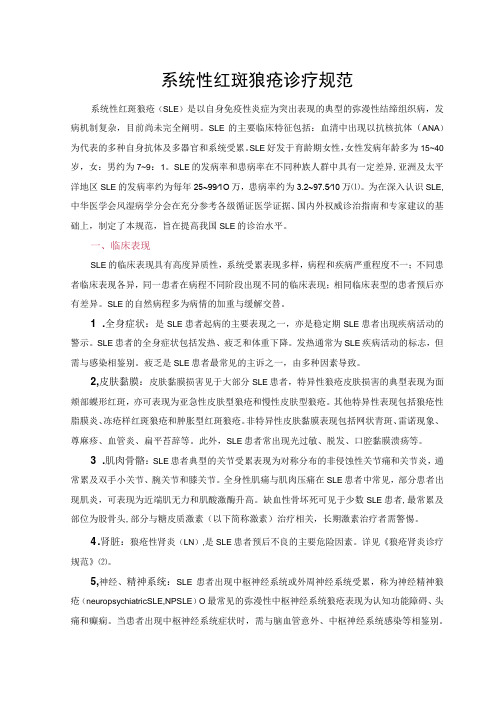
系统性红斑狼疮诊疗规范系统性红斑狼疮(SLE)是以自身免疫性炎症为突出表现的典型的弥漫性结缔组织病,发病机制复杂,目前尚未完全阐明。
SLE的主要临床特征包括:血清中出现以抗核抗体(ANA)为代表的多种自身抗体及多器官和系统受累。
SLE好发于育龄期女性,女性发病年龄多为15~40岁,女:男约为7~9:1。
SLE的发病率和患病率在不同种族人群中具有一定差异,亚洲及太平洋地区SLE的发病率约为每年25~99∕1O万,患病率约为3.2~97.5∕10万⑴。
为在深入认识SLE,中华医学会风湿病学分会在充分参考各级循证医学证据、国内外权威诊治指南和专家建议的基础上,制定了本规范,旨在提高我国SLE的诊治水平。
一、临床表现SLE的临床表现具有高度异质性,系统受累表现多样,病程和疾病严重程度不一;不同患者临床表现各异,同一患者在病程不同阶段出现不同的临床表现;相同临床表型的患者预后亦有差异。
SLE的自然病程多为病情的加重与缓解交替。
1 .全身症状:是SLE患者起病的主要表现之一,亦是稳定期SLE患者出现疾病活动的警示。
SLE患者的全身症状包括发热、疲乏和体重下降。
发热通常为SLE疾病活动的标志,但需与感染相鉴别。
疲乏是SLE患者最常见的主诉之一,由多种因素导致。
2,皮肤黏膜:皮肤黏膜损害见于大部分SLE患者,特异性狼疮皮肤损害的典型表现为面颊部蝶形红斑,亦可表现为亚急性皮肤型狼疮和慢性皮肤型狼疮。
其他特异性表现包括狼疮性脂膜炎、冻疮样红斑狼疮和肿胀型红斑狼疮。
非特异性皮肤黏膜表现包括网状青斑、雷诺现象、尊麻疹、血管炎、扁平苔辞等。
此外,SLE患者常出现光过敏、脱发、口腔黏膜溃疡等。
3 .肌肉骨骼:SLE患者典型的关节受累表现为对称分布的非侵蚀性关节痛和关节炎,通常累及双手小关节、腕关节和膝关节。
全身性肌痛与肌肉压痛在SLE患者中常见,部分患者出现肌炎,可表现为近端肌无力和肌酸激酶升高。
缺血性骨坏死可见于少数SLE患者,最常累及部位为股骨头,部分与糖皮质激素(以下简称激素)治疗相关,长期激素治疗者需警惕。
系统性红斑狼疮(SLE)概述

SLICC对SLE的最新分类标准
确诊标准:满足上述4项标准,包括至少1项临床标准和1项免疫学标准; 或肾活检证实狼疮肾炎,同时抗核抗体阳性或抗dsDNA抗体阳性。
病情评估
SLE的诊断和治疗
处理难控制的病理
抢救SLE危重症
处理或防治药物不良反应
处理SLE患者面对的特殊情况,如:妊娠、手术等。
发病机制
01
IgG型为主,与自身抗原具有很高的亲和力
致病性自身抗体
02
增高原因:清除IC的机制异常IC形成过多(抗体量多)因IC的大小不当,不能被吞噬或排出
致病性免疫复合物
03
CD8+T细胞和NK细胞功能失调,不能抑制CD4+T细胞,B细胞持续活化产生自身抗体。T细胞的功能异常以致新抗原不断出现,使自身免疫不断持续存在。
口腔损害 有7%-40%的SLE患者有口腔损害,以颊粘膜糜烂和溃疡最为常见; 口腔溃疡是SLE常见首发症状之一,常与病情活动相关。厌食、恶心、呕吐、腹泻 儿童中较为常见肝脏病变 SLE肝大的发生率为10%-32%。胰腺炎 胰腺炎可能是SLE的首发现象。
血液系统
SLE血液系统受累常与病情活动相关,也可为SLE的首发症状。
在用环磷酰胺将狼疮肾炎、脑病或血管炎控制后,可用MTX维持治疗,也可用于神经精神狼疮,尤其是癫痫大发作时的鞘内注射,这种局部用药可减少全身免疫抑制药的使用,减少感染等并发症的发生,并能有效缓解狼疮脑病患者的病情,被认为是较好的治疗方法
对于轻到中度的SLE,MTX可作为减少激素用量的替代药物。由于MTX对肾有影响,因此一般不适用与LN患者。
治疗SLE的药物
小剂量GCs(相当于泼尼松≤7.5mg/d)通常应用在其它初始治疗(如抗疟药)无法耐受或不足以控制疾病活动的时候。
抗核糖体P蛋白

抗核糖体P蛋白抗体
科技名词定义
中文名称:抗核糖体P蛋白抗体
英文名称:anti-ribosomal P-protein autoantibody
其他名称:抗rRNP抗体
定义:系统性红斑狼疮的高度特异性血清学标志抗体。
其靶抗原位于核糖体60S亚单位。
应用学科:免疫学(一级学科);免疫系统(二级学科);免疫分子(三级学科)
以上内容由全国科学技术名词审定委员会审定公布
先进性及可行性:
抗核糖体P蛋白抗体是系统性红斑狼疮的特异性抗体,其他疾病和正常人中很少见。
而且有研究表明,抗核糖体P蛋白抗体与红斑狼疮的神经精神损害有很大的相关性,认为其是SLE患者肝脏损害和肾炎有关,抗核糖体P 蛋白抗体与红斑狼疮的病情活动也相关。
而且抗核糖体P蛋白初筛ELISA基于重组核糖体P多肽的准确诊断和应用已经在广泛的国际多中心研究中得到确认。
所以作为临床辅助诊断是必需的。
临床意义:
在风湿性疾病患者中,抗核糖体P蛋白抗体几乎只对系统性红斑狼疮(SLE)特异,为SLE的标志性抗体。
其与狼疮肾炎相关很普遍,与无肾炎等狼疮患者相比有统计学意义,抗核糖体P蛋白抗体滴度升高合并有抗
ds-DNA抗体在有肾炎的患者中尤为显著。
抗核糖体P蛋白抗体的效价升高在SLE相关慢性活动性肝炎中高度特异性,区别于抗平滑肌抗体阳性,先天性慢性自身免疫活动性肝炎。
在其它自身免疫病患者中很少发现抗核糖体P 蛋白抗体滴度的升高。
斑马鱼补体蛋白3(C3)酶联免疫分析
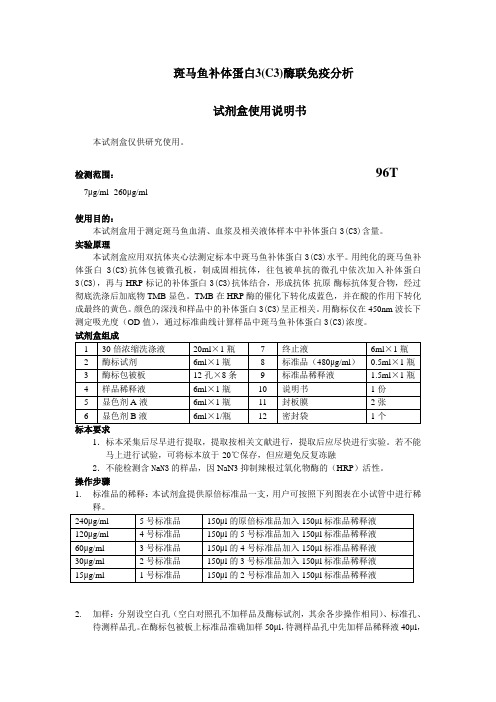
斑马鱼补体蛋白3(C3)酶联免疫分析试剂盒使用说明书本试剂盒仅供研究使用。
检测范围:96T7μg/ml -260μg/ml使用目的:本试剂盒用于测定斑马鱼血清、血浆及相关液体样本中补体蛋白3(C3)含量。
实验原理本试剂盒应用双抗体夹心法测定标本中斑马鱼补体蛋白3(C3)水平。
用纯化的斑马鱼补体蛋白3(C3)抗体包被微孔板,制成固相抗体,往包被单抗的微孔中依次加入补体蛋白3(C3),再与HRP标记的补体蛋白3(C3)抗体结合,形成抗体-抗原-酶标抗体复合物,经过彻底洗涤后加底物TMB显色。
TMB在HRP酶的催化下转化成蓝色,并在酸的作用下转化成最终的黄色。
颜色的深浅和样品中的补体蛋白3(C3)呈正相关。
用酶标仪在450nm波长下测定吸光度(OD值),通过标准曲线计算样品中斑马鱼补体蛋白3(C3)浓度。
试剂盒组成标本要求1.标本采集后尽早进行提取,提取按相关文献进行,提取后应尽快进行实验。
若不能马上进行试验,可将标本放于-20℃保存,但应避免反复冻融2.不能检测含NaN3的样品,因NaN3抑制辣根过氧化物酶的(HRP)活性。
操作步骤1.标准品的稀释:本试剂盒提供原倍标准品一支,用户可按照下列图表在小试管中进行稀2.加样:分别设空白孔(空白对照孔不加样品及酶标试剂,其余各步操作相同)、标准孔、待测样品孔。
在酶标包被板上标准品准确加样50μl,待测样品孔中先加样品稀释液40μl,然后再加待测样品10μl(样品最终稀释度为5倍)。
加样将样品加于酶标板孔底部,尽量不触及孔壁,轻轻晃动混匀。
3.温育:用封板膜封板后置37℃温育30分钟。
4.配液:将30倍浓缩洗涤液用蒸馏水30倍稀释后备用5.洗涤:小心揭掉封板膜,弃去液体,甩干,每孔加满洗涤液,静置30秒后弃去,如此重复5次,拍干。
6.加酶:每孔加入酶标试剂50μl,空白孔除外。
7.温育:操作同3。
8.洗涤:操作同5。
9.显色:每孔先加入显色剂A50μl,再加入显色剂B50μl,轻轻震荡混匀,37℃避光显色10分钟.10.终止:每孔加终止液50μl,终止反应(此时蓝色立转黄色)。
马传染性贫血病毒cELISA抗体检测试剂盒技术参数
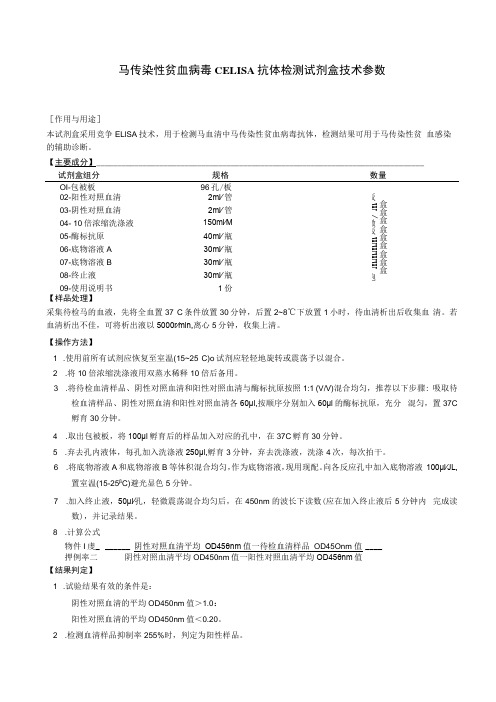
马传染性贫血病毒CELISA抗体检测试剂盒技术参数[作用与用途]本试剂盒采用竞争ELlSA技术,用于检测马血清中马传染性贫血病毒抗体,检测结果可用于马传染性贫血感染的辅助诊断。
【主要成分】______________________________________________________________________________采集待检马的血液,先将全血置37°C条件放置30分钟,后置2~8℃下放置1小时,待血清析出后收集血清。
若血清析出不佳,可将析出液以5000r∕min,离心5分钟,收集上清。
【操作方法】1 .使用前所有试剂应恢复至室温(15~25°C)o试剂应轻轻地旋转或震荡予以混合。
2 .将10倍浓缩洗涤液用双蒸水稀释10倍后备用。
3 .将待检血清样品、阴性对照血清和阳性对照血清与酶标抗原按照1:1 (V/V)混合均匀,推荐以下步骤: 吸取待检血清样品、阴性对照血清和阳性对照血清各60μl,按顺序分别加入60μl的酶标抗原,充分混匀,置37C 孵育30分钟。
4 .取出包被板,将100μl孵育后的样品加入对应的孔中,在37C孵育30分钟。
5 .弃去孔内液体,每孔加入洗涤液250μl,孵育3分钟,弃去洗涤液,洗涤4次,每次拍干。
6 .将底物溶液A和底物溶液B等体积混合均匀,作为底物溶液,现用现配。
向各反应孔中加入底物溶液100μl∕JL,置室温(15-25βC)避光显色5分钟。
7 .加入终止液,50μl∕孔,轻微震荡混合均匀后,在450nm的波长下读数(应在加入终止液后5分钟内完成读数),并记录结果。
8 .计算公式物件I虔_ ______ 阴性对照血清平均OD45θnm 值一待检血清样品OD45Onm 值____押例率二阴性对照血清平均OD450nm值一阳性对照血清平均OD45θnm值【结果判定】1 .试验结果有效的条件是:阴性对照血清的平均OD450nm值>1.0:阳性对照血清的平均OD450nm值<0.20。
SLE66CLX320P_datasheet
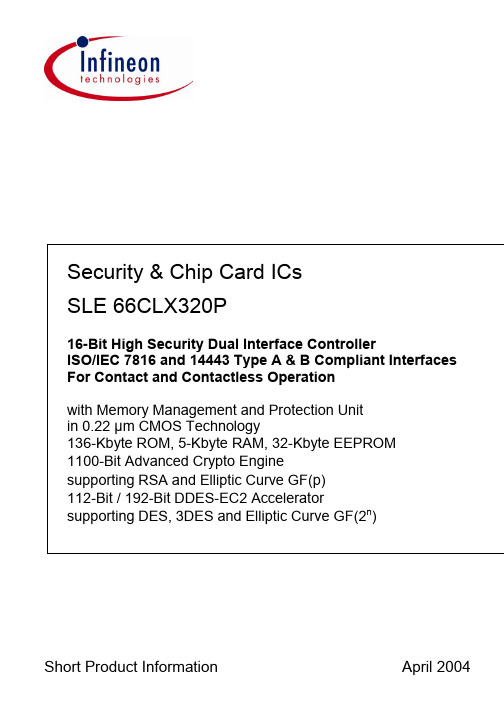
Security & Chip Card ICsSLE 66CLX320P16-Bit High Security Dual Interface ControllerISO/IEC 7816 and 14443 Type A & B Compliant Interfaces For Contact and Contactless Operationwith Memory Management and Protection Unitin 0.22 µm CMOS Technology136-Kbyte ROM, 5-Kbyte RAM, 32-Kbyte EEPROM1100-Bit Advanced Crypto Enginesupporting RSA and Elliptic Curve GF(p)112-Bit / 192-Bit DDES-EC2 Acceleratorsupporting DES, 3DES and Elliptic Curve GF(2n)SLE 66CLX321P Short Product Information Ref.: SPI_SLE66CLX320P_0404.doc This document contains preliminary information on a new product under development. Details are subject to change without notice.Revision History: Current Version 2004-04-01Previous Releases: 2004-02-12Page4 Type A baud rate support of 106kbit/sImportant: Further information is confidential and on request. Please contact:Infineon Technologies AG in Munich, Germany,Security & Chip Card ICs,Tel +49 - (0)89 234-80000Fax +49 - (0)89 234-81000E-Mail: security.chipcard.ics@Published by Infineon Technologies AG, SMS Security Applications GroupSt.-Martin-Strasse 53, D-81541 München© Infineon Technologies AG 2004All Rights Reserved.To our valued customersWe constantly strive to improve the quality of all our products and documentation. We have spent an exceptional amount of time to ensure that this document is correct. However, we realise that we may have missed a few things. If you find any information that is missing or appears in error, please use the contact section above to inform us. We appreciate your assistance in making this a better document.Attention please!The information herein is given to describe certain components and shall not be considered as warranted characteristics.Terms of delivery and rights to technical change reserved.We hereby disclaim any and all warranties, including but not limited to warranties of non-infringement, regarding circuits, descriptions and charts stated herein.Infineon Technologies is an approved CECC manufacturer.InformationFor further information on technology, delivery terms and conditions and prices please contact your nearest Infineon Technologies Office in Germany or our Infineon Technologies Representatives world-wide (see address list).WarningsDue to technical requirements components may contain dangerous substances. For information on the types in question please contact your nearest Infineon Technologies Office.Infineon Technologies Components may only be used in life-support devices or systems with the express written approval of Infineon Technologies, if a failure of such components can reasonably be expected to cause the failure of that life-support device or system, or to affect the safety or effectiveness of that device or system. Life support devices or systems are intended to be implanted in the human body, or to support and/or maintain and sustain and/or protect human life. If they fail, it is reasonable to assume that the health of the user or other persons may be endangered.16-Bit High Security Dual Interface ControllerISO/IEC 7816 and 14443 Type A &B Compliant InterfacesFor Contact and Contactless Operation with MMU in 0.22 µm CMOS Technology 136-Kbyte ROM, 5-Kbyte RAM, 32-Kbyte EEPROM1100-Bit Advanced Crypto Engine supporting RSA and Elliptic Curve GF (p) and 112-Bit / 192-Bit DDES-EC2 Acceleratorsupporting DES, 3DES and Elliptic Curve GF (2n)Features•Enhanced low power 8051 CPU with extended addressing modes for dualinterface smart card applications •Instruction set opcode compatible with standard 8051 processor with additionalpowerful instructions optimized for smartcard application•Enhanced architecture with execution time6 times faster (18 times usingPLLmax) than standard 8051 processor at same external clock•134 Kbytes User ROM for operating system and application (programs & data)• 2 Kbytes reserved ROM for Resource Management System (RMS_E) withContactless Optimized EEPROMwrite/erase routines•32 Kbytes Secure EEPROM inSuperSlim technology for applicationprogram and data•4k bytes XRAM, 700 bytes Crypto-RAM and 256 bytes internal RAM for fast data processing•Memory Management Unit •Certified True Random NumberGenerator•Dual Key Triple DES (DDES) &GF(2n) Elliptic Curve (EC2) Accelerator •Advanced Crypto Engine for Elliptic Curve GF(p) and up to 2048 bits RSAcomputation•CRC Module according to ISO/IEC 3309 supporting CCIT v.41 & HDLC X25•8 Interrupt Vectors Module with 3 priority levels to ensure real time operation •PLL: to speed up the internal CPU clock frequency up to 15MHz (optional use)•Two 16-bit Timers with interrupt capability for protocols, security checks & watch dog implementations•Power saving sleep mode •Temperature range:contact-based: -25°C to +85°Ccontact-less: -25°C to +70°CFull operation either via Contact-based and/or Contactless interfaces controlled by Operating System enhances Security LevelContact-based Interface•Contact configuration and serialinterface according to ISO/IEC 7816 •UART handling serial interface compliant with ISO/IEC 7816 supportingtransmission protocols T=0 and T=1•Supply voltage range:5V ± 10% (Class A)3V ± 10% (Class B)•Current consumption < 10 mA @ 5.5 V •External CPU clock frequency:1 to 7.5 MHz•Internal CPU clock frequency:up to 15 MHz•ESD protection larger than 6 kVContactless Interface•Interface according to ISO/IEC 14443 for both Type A and Type B•Carrier frequency 13.56 MHz•Data rate106 Kbit/s in type A operationup to 848 Kbit/s in type B operation •Anticollision & Transmission Protocol supported by open source applicationnotes for both Type A & B •Flexible Internal CPU clock frequency: fully configurable from 1.7MHz up to15 MHz•256 bytes buffer for contactless data exchange (FiFo circular architecture) •Parallel operation of CPU, Peripherals like DES, CRC and Contactless Interface possible for High DemandingContactless Applications EEPROM (SuperSlim Technology) •Byte wise EEPROM programming and read accesses•Versatile & Flexible page mode for 1 to 256 bytes write/erase operation•32 bytes security area including:- 16 bytes chip unique identification number - 16 bytes PROM area (OTP like) •Fast personalisation mode 1.5 ms •Typical Page Erase time < 2.5ms •Typical Page Writing time < 1.8 ms •Minimum of 100.000 Write/erase cycles1)•Data retention for a minimum of 10 years1)•EEPROM programming voltage generated on chipMemory Management and Protection Unit•Addressable memory up to 1 Mbytes •Separates OS (system mode) andApplication (application mode) •System routines called by traps •Access Restrictions to peripherals in application mode controlled by OS •Code execution from XRAM possible1) Values are temperature dependantSecurity FeaturesOperation state monitoring mechanism The chip goes in a secure reset state on any following sensors alarm:•Low and high voltage sensors •Internal voltage sensor •Frequency sensors and filters•Light sensor•Glitch sensor•Temperature sensor•Life Test Sensor•Internal power-on reset sensor •Active Shield with automatic and user controlled attack detectionSecure chip and firmware design •Security scrambled & optimized chip layout against physical chip manipulation •Memory encryption/decryption module (MED) for XRAM, ROM and EEPROMagainst reverse engineering and powerattacks•ROM code not visible due to implantation •Mask dependant ROM code encrypted during production•Chip Unique encryption of the XRAM and EEPROM•Flexible encryption of part or whole EEPROM by additional user-defined key •16 byte Unique chip identification number for anti-clone countermeasure & tracking •16 bytes security PROM hardware protected (OTP like)•Secure start of the operating system ensured by certified Self Test Software(STS)•Certified EEPROM programming routines (RMS_E)•True Random Number Generator with Firmware test function•High Speed SPA/DPA resistant Triple DES (DDES) Accelerator and AdvancedCrypto Engine Anti Snooping•HW-countermeasures against SPA/DPA-, Timing- and DFA-attacks (differential fault analysis)Supported Standards•ISO/IEC 7816•EMV 2000•GSM 11.1x•ETSI TS 102 221•ISO/IEC 14443•ISO/IEC 3309•CCIT v.41•HDLC X25Application Support•HW-& SW-Tools (Emulator, ROM Monitor, Card Emulator, Simulator, Evaluation Kit Proximity (Contactless Reader package), SmartMask™ package, Simulated Reader Software, etc.)•Open Source Application Notes Tutorial(e.g.: T=0, T=1, DES and 3DES, CryptoLibrary, Anticollision and ContactlessTransmission Protocols for both Type Aand B, Card Coil Design Guide, Card Coil Antenna Reference Design List, etc.) •Certified CC EAL5+ Crypto Library •Worldwide Application Engineer Team and customer dedicated Field ApplicationEngineers•Regular Customer trainings onCryptography, Contactless and Dualinterface controllers including ISO/IEC14443 related topics•On-site trainings available on requestDocument References •Confidential Data Book SLE 66CxxP •Confidential Instruction Set SLE 66CxxP •Confidential Quick Reference SLE 66CxxP •Chip Qualification report•Chip delivery specification for wafer with chip-layout (die size, orientation, ...) •Module specification containing description of package, etc.•Module Qualification reportDevelopment Tools Overview •Software Development Kit SDK CC •Card Emulator CE66P Dual Interface •ROM Monitor RM66P-II with stand alone functionality for ROM mask qualification in the end user system•Emulator ET66P Hitex or ET66P KSC •Smart Mask™ Package for chip evaluation •Smart Mask™ Dual Interface modules M8.4 (supplied by Infineon) supporting both ISO/IEC 14443 Type A & B and ISO/IEC7816 for implantation process testing andproduction setup•Evaluation Kit Proximity (Contactless reader package)Timing performances are independent of the contact or contactless interface.Table 1 Performance Advanced Crypto EngineOperation Modulus ExponentCalculation Time at 5 MHz Calculation Time at15 MHzModular Exponentiation 160 bit 160 bit 20 ms 7 ms Modular Exponentiation 256 bit 256 bit 35 ms 12 ms Modular Exponentiation512 bit 512 bit 110 ms 37 ms Modular ExponentiationRSA Encrypt / RSA Signature Verify 1024 bit 16 bit 20 ms 7 ms Modular ExponentiationRSA Decrypt / RSA Signature Generate 1024 bit1024 bit820 ms273 ms Modular Exponentiation using CRTRSA Decrypt / RSA Signature Generate eq.1024 bit eq.1024 bit 250 ms 83 ms DSA Signature Generate 512 bit 160 bit 145 ms 48 ms DSA Signature Verify 512 bit 160 bit 130 ms 43 ms DSA Signature Generate 1024 bit 160 bit 290 ms 97 ms DSA Signature Verify1024 bit 160 bit 360 ms 120 ms Elliptic Curves EC-GDSA Sign. Generate 160 bit160 bit 260 ms 87 ms Elliptic Curves EC-GDSA Sign. Verify. 160 bit160 bit550 ms183 msFeatures (cont’d)Table 2Performance DDES-EC2 AcceleratorEncryption Time for an 8-byte Block including Data TransferOperation Data BlockLength5 MHz15 MHz High Speed and Secure 56-bit Single DES Encryption (incl. key loading) 64 bit 37 µs 12 µs High Speed and Secure56-bit Single DES Encryption64 bit23 µs 8 µs High Speed and Secure 112-bit Triple DES Encryption (incl. key loading)64 bit 60 µs 20 µs High Speed and Secure112-bit Triple DES Encryption 64 bit 35 µs12 µsCalculation TimeOperand Length5 MHz 15 MHz Elliptic Curves GF(2n ) EC-DSA Signature Generate 192 bit 285 ms 95 ms Elliptic Curves GF(2n ) EC-DSA Signature Verify 192 bit540 ms180 msTable 3 Ordering Information 1Type Package Voltage Range TemperatureRange Frequency Range (external clock) SLE 66CLX320P – M8.4 M8.42 SLE 66CLX320P – C Chip2.7 V - 5.5 V– 25°C to + 85°C1 MHz – 7.5 MHz1 Ordering Codes are available on request 2Dual Interface Module (M8.4)Pin DescriptionC1C5C2C6C3C7C4C8 Figure 1 M8.4 Pin Configuration Wire-bonded Module (top view)Figure 2 Pad Configuration (die)Table 4 Pin Definitions and FunctionsCard Contact Symbol FunctionvoltageC1 VDDSupplyinputC2 RSTResetC3 CLK Processor clock inputGroundC5 GNDC7 I/O Bi-directional data portLA Coil connection pin LALB Coil connection pin LBGeneral DescriptionThe dual interface security controller SLE 66CLX320P is a member of the Infineon Technologies SLE 66CxxxP high-end security controller family in 0.22 µm CMOS technology which is designed for security systems that requires continuous ongoing improvements with the highest degree of protection against fraudulent attacks.SLE 66CLX320P is targeting dual interface smart card applications such like national ID cards, banking, security access, digital signature and transport..SLE 66CLX320P offers 134 Kbytes of User-ROM, 256 bytes internal RAM, 4 Kbytes XRAM, 700 bytes Crypto RAM and 32 Kbytes EEPROM, which can be used as data and as program memory. The non-volatile memory consists of high reliability cells to guarantee data integrity. This is especially important when the EEPROM is used as program memory.It features ISO/IEC 14443 Type A and B contactless interfaces as well as an ISO/IEC 7816 contact-based interface on a single chip that can be operated in parallel. It also supports symmetric and asymmetric public-key algorithm such like DES, 3DES, Elliptic Curves and RSA independently of the communication mode.Figure 2: Block Diagram of SLE 66CLX320PThe CPU provides the high efficiency of the 8051 instruction set extended by additional powerful instructions with enhanced performance, memory sizes and security features tailored for contact and contactless smart card applications. Using the embedded PLL, the internal clock is adjustable up to 15 MHz independent from the carrier frequency of the magnetic field supplied by the contactless terminal.The Memory Management Unit allows a secure separation of the operating system and the applications. Using the system/application mode, it allows to securely downloading applications in the field after card personalisation. Using the MMU transparent mode allows keeping the memory mapping for code compatibility to SLE 66CxxS family. These new features suit the requirements of the new generation of operating systems.The UART supports the half-duplex transmission protocols T=0 and T= 1 according to ISO/IEC 7816-3. All relevant transmission parameters can be adjusted by software, as e.g. the clock division factor, direct/inverse convention and the number of stop bits. Additionally, the I/O port can be driven by communication routines realized in software. To minimize the overall power consumption, the smart card controller can be set into sleep mode supporting clock stop mode. Timers ease the implementation of advanced communication protocols such as T=CL (according to ISO/IEC 14443-4) and all other time critical processes for contactless communications. Both Timers features auto-reload mechanisms as well as their own dedicated interrupt vectors. Additional interrupts capability of the RF interface module allows real time operation of the pure contactless smart card with the contactless terminals.SLE 66CLX320P is able to communicate with any Proximity Card Device (PCD) defined in ISO/IEC 14443 such as the Infineon Evaluation Kit Proximity over a typical coupling distance of 10 cm. The power supply and data are received by an antenna, which consists of a coil with a few turns directly connected to the IC. DES acceleration by a factor of more than 500 compared to software solutions in combination with the high data transfer rate up to 848 Kbit/s keep the transaction times short. For more independence and flexibility, the controller offers the two modulation type A and type B according ISO/IEC 14443.The Anticollision and Contactless Transmission Protocol are supported by open source application notes for both Type A and B in order to offer a maximum flexibility to the Operating System. Both Contactless Communication protocol may be implemented in the Operating System while the final selection of the Type A or B is based upon the personalisation data of the contactless smart card. The communication type can also be changed during runtime in the field. Thus, SLE 66CLX320P ensures a simplified handling of the ROM mask, high reactivity by a tailored personalisation during production of the contactless smart card in order to answer to the increasing market demand and applications.SLE 66CLX320P features a new Resource Management System (RMS_E) which optimizes Contactless EEPROM write/erase routines. EEPROM programming is enhanced over the entire communication distance compared to the standard RMS. Thus, the reduction of programming times and power consumption is ensured independently of the use of the contact or the contactless interface.The CRC module allows the easy generation of checksums according to ISO/IEC 3309 (16-Bit-CRC), thus it supports the two different CRC calculation required for ISO/IEC 14443 Type A and Type B. Also, data as well as program located in the EEPROM can be extra-secured by a CRC checksum enabling the Operating System to detect errors while downloading new application in the field.To minimize the overall power consumption, the pure contactless smart card controller can be set into sleep mode.The certified random number generator (RNG) is able to supply the CPU with true random numbers on all conditions. It allows creating session key used for authentication in open networks and enable secure downloading of new applications.The DDES-EC2 accelerator consists of two modules.The DDES module supports symmetrical crypto algorithms according to the Data Encryption Standard in the Electronic Code Book Mode. It features two internal registers for storage of the two keys required for a Triple DES computation. Together with the fast contactless interface, it offers high security and high speed for dual interface smart card applications.The EC2 module accelerates the multiplication in GF (2n) and therefore the operations for elliptic curve cryptography. It widens the field of application for SLE 66CLX320P since it can be used as tamper-resistant security tool for secured and authentic communication in open networks.The Advanced Crypto Engine (ACE) is equipped with its own RAM of 700 bytes and supports all of today known public-key algorithms based on large integer modular arithmetic. It allows fast and efficient calculation of e.g. RSA operations with key lengths up to 2048 bit and Elliptic Curve GF (p).As an important feature, SLE 66CLX320P provides a new and enhanced level of on-chip security, which fulfils the strong security requirements of a Common Criteria evaluation at an EAL5 level. Each security measure is designed to act as an integral part of the complete system in order to strengthen the system as a whole.Thus, porting an existing Operating System to SLE 66CLX320P requires only very limited changes as it is typically reduced to add the Contactless Library and the Contactless Optimized Resource Management System (RMS_E) to the existing Operating System.SLE 66CLX320P integrates outstanding memory sizes, additional peripherals in combination with enhanced performance and optimized power consumption on a minimized die size.In conclusion, SLE 66CLX320P fulfils the requirements of for both contact-based and contactless smart card applications such like national ID card, banking, security access, digital signature and transport. In the case a pure contactless security controller is required, SLE 66CLX321P offers a solution without the contact-based interface of the SLE 66CLX320P.。
SLE患者血清免疫球蛋白及补体C3含量检测
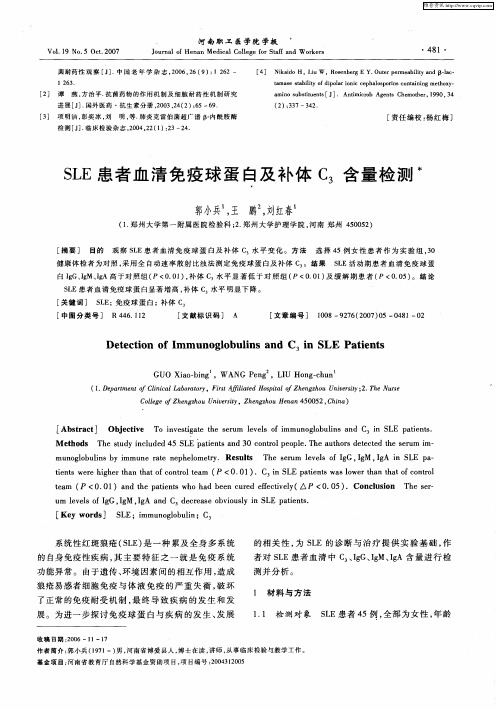
[ b tat 0 jcie T net a h eu eeso m n g b 1 sad C nS E pt ns A s c] b et oivsgt tesrm lvl fi u o1 ui n 3i L a e t r v i e m o n i .
M eho Th t d n l e 5 S a in sa d 3 o to e p e Th u h r e e td t e u i — t ds e su y i cud d 4 LE p te t n 0 c n r lp o l . e a t o sd tc e hes r m m mu o l b ln y i n go u i sb mmu ae e h lm er ne r t n p e o ty. R e u t Th e u lv l f I G , g , g i S E a s ls e s r m e es o g I M I A n L p —
( . eat e t f Cii l a oao , 1 D p r n o l c b rtr n f l t o i l Z eg h u U i r t ; . h us m n aL y f f i e H s t hn zo n e i 2 T eN r A a d pao i f v sy e C l g h n z o nvr t , h n zo ea 5 0 2 C ia o e eo Z e g h u U i sy Z eg h uH n n4 0 5 ,eh h rh nta o nr a ( 0 0 ) 3nS Ep t ns a w rh nta o nrl i t w r i e a t f o t l em P< . 1 .C L a et w so e a t f o t e g t h c ot i i l t h c o ta ( < . 1 n ep t ns h a enc rde et e ( P< . 5 .C n ls n T esr em P 0 0 )a dt a e t w oh db e ue f c v l △ h i fi y 0 0 ) o c i h e— uo
22c3抗体评分的标准
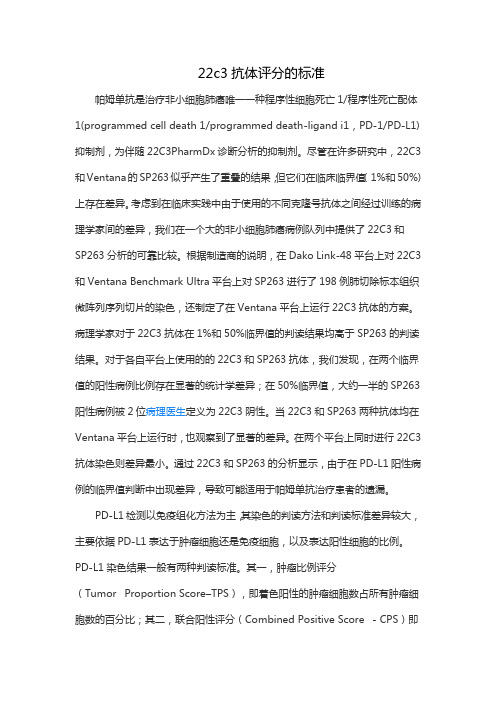
22c3抗体评分的标准帕姆单抗是治疗非小细胞肺癌唯一一种程序性细胞死亡1/程序性死亡配体1(programmed cell death 1/programmed death-ligand i1,PD-1/PD-L1)抑制剂,为伴随22C3PharmDx诊断分析的抑制剂。
尽管在许多研究中,22C3和Ventana的SP263似乎产生了重叠的结果,但它们在临床临界值(1%和50%)上存在差异。
考虑到在临床实践中由于使用的不同克隆号抗体之间经过训练的病理学家间的差异,我们在一个大的非小细胞肺癌病例队列中提供了22C3和SP263分析的可靠比较。
根据制造商的说明,在Dako Link-48平台上对22C3和Ventana Benchmark Ultra平台上对SP263进行了198例肺切除标本组织微阵列序列切片的染色,还制定了在Ventana平台上运行22C3抗体的方案。
病理学家对于22C3抗体在1%和50%临界值的判读结果均高于SP263的判读结果。
对于各自平台上使用的的22C3和SP263抗体,我们发现,在两个临界值的阳性病例比例存在显著的统计学差异;在50%临界值,大约一半的SP263阳性病例被2位病理医生定义为22C3阴性。
当22C3和SP263两种抗体均在Ventana平台上运行时,也观察到了显著的差异。
在两个平台上同时进行22C3抗体染色则差异最小。
通过22C3和SP263的分析显示,由于在PD-L1阳性病例的临界值判断中出现差异,导致可能适用于帕姆单抗治疗患者的遗漏。
PD-L1检测以免疫组化方法为主,其染色的判读方法和判读标准差异较大,主要依据PD-L1表达于肿瘤细胞还是免疫细胞,以及表达阳性细胞的比例。
PD-L1染色结果一般有两种判读标准。
其一,肿瘤比例评分(Tumor Proportion Score–TPS),即着色阳性的肿瘤细胞数占所有肿瘤细胞数的百分比;其二,联合阳性评分(Combined Positive Score - CPS)即着色的肿瘤细胞、淋巴细胞及巨噬细胞数之和占全部存活肿瘤细胞的百分比,再乘以100。
CD分子
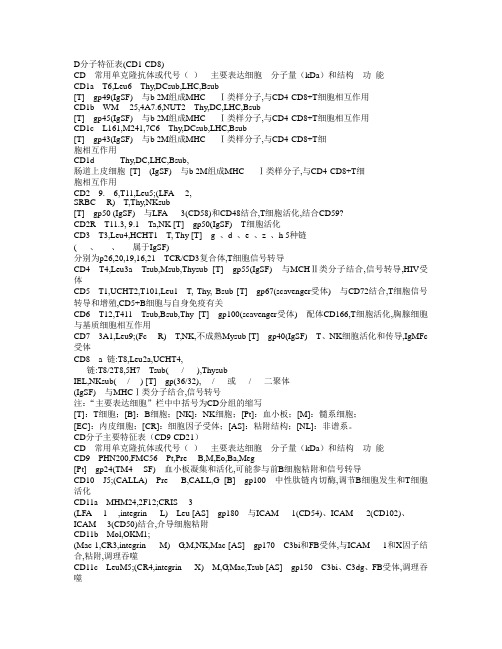
D分子特征表(CD1-CD8)CD 常用单克隆抗体或代号()主要表达细胞分子量(kDa)和结构功能CD1a T6,Leu6 Thy,DCsub,LHC,Bsub[T] gp49(IgSF) 与b 2M组成MHCⅠ类样分子,与CD4-CD8+T细胞相互作用CD1b WM25,4A7.6,NUT2 Thy,DC,LHC,Bsub[T] gp45(IgSF) 与b 2M组成MHCⅠ类样分子,与CD4-CD8+T细胞相互作用CD1c L161,M241,7C6 Thy,DCsub,LHC,Bsub[T] gp43(IgSF) 与b 2M组成MHCⅠ类样分子,与CD4-CD8+T细胞相互作用CD1d Thy,DC,LHC,Bsub,肠道上皮细胞[T] (IgSF) 与b 2M组成MHCⅠ类样分子,与CD4-CD8+T细胞相互作用CD2 9. 6,T11,Leu5;(LFA2,SRBC R) T,Thy,NKsub[T] gp50 (IgSF) 与LFA3(CD58)和CD48结合,T细胞活化,结合CD59?CD2R T11.3, 9.1 Ta,NK [T] gp50(IgSF) T细胞活化CD3 T3,Leu4,HCHT1 T, Thy [T] g 、d 、e 、z 、h 5种链( 、 、 属于IgSF)分别为p26,20,19,16,21 TCR/CD3复合体,T细胞信号转导CD4 T4,Leu3a Tsub,Msub,Thysub [T] gp55(IgSF) 与MCHⅡ类分子结合,信号转导,HIV受体CD5 T1,UCHT2,T101,Leu1 T, Thy, Bsub [T] gp67(scavenger受体) 与CD72结合,T细胞信号转导和增殖,CD5+B细胞与自身免疫有关CD6 T12,T411 Tsub,Bsub,Thy [T] gp100(scavenger受体) 配体CD166,T细胞活化,胸腺细胞与基质细胞相互作用CD7 3A1,Leu9;(Fc R) T,NK,不成熟Mysub [T] gp40(IgSF) T、NK细胞活化和传导,IgMFc 受体CD8 a 链:T8,Leu2a,UCHT4,链:T8/2T8,5H7 Tsub( / ),ThysubIEL,NKsub( / ) [T] gp(36/32), / 或 / 二聚体(IgSF) 与MHCⅠ类分子结合,信号转号注:“主要表达细胞”栏中中括号为CD分组的缩写[T]:T细胞;[B]:B细胞;[NK]:NK细胞;[Pt]:血小板;[M]:髓系细胞;[EC]:内皮细胞;[CR]:细胞因子受体;[AS]:粘附结构;[NL]:非谱系。
slc32pda228英文规格书
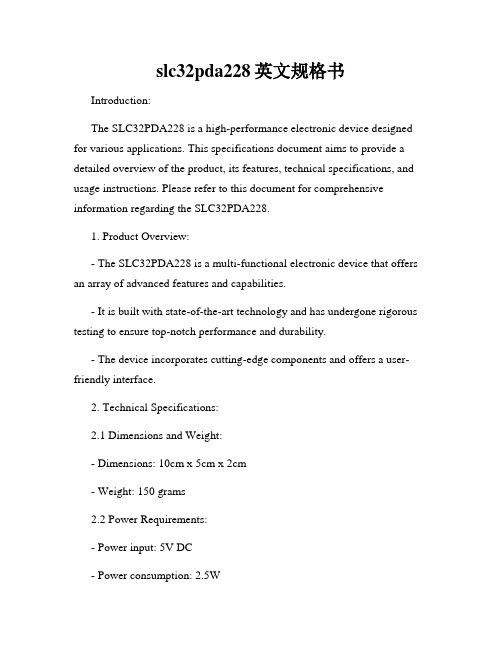
slc32pda228英文规格书Introduction:The SLC32PDA228 is a high-performance electronic device designed for various applications. This specifications document aims to provide a detailed overview of the product, its features, technical specifications, and usage instructions. Please refer to this document for comprehensive information regarding the SLC32PDA228.1. Product Overview:- The SLC32PDA228 is a multi-functional electronic device that offers an array of advanced features and capabilities.- It is built with state-of-the-art technology and has undergone rigorous testing to ensure top-notch performance and durability.- The device incorporates cutting-edge components and offers a user-friendly interface.2. Technical Specifications:2.1 Dimensions and Weight:- Dimensions: 10cm x 5cm x 2cm- Weight: 150 grams2.2 Power Requirements:- Power input: 5V DC- Power consumption: 2.5W2.3 Storage and Memory:- Internal storage capacity: 128GB - RAM: 8GB2.4 Display:- Screen size: 5.5 inches- Resolution: 1920 x 1080 pixels - Display type: LCD2.5 Connectivity:- Wi-Fi: 802.11ac- Bluetooth: 5.0- USB: Type-C2.6 Processor and Performance: - Processor: Quad-core 2.5 GHz - Operating system: Android 10 - Graphics: Adreno 6502.7 Camera:- Rear camera: 16MP- Front camera: 8MP2.8 Additional Features:- Fingerprint sensor- Accelerometer- Gyroscope3. Usage Instructions:3.1 Powering on/off the SLC32PDA228:- To power on the device, press and hold the power button for a few seconds until the screen lights up.- To power off the device, press and hold the power button, then select "Power off" from the options provided.3.2 Connecting to Wi-Fi:- Navigate to the "Settings" menu on the device.- Select "Wi-Fi" and turn it on.- Choose the desired Wi-Fi network from the available options and enter the password if required.3.3 Taking Photos:- Open the camera app on the device.- Aim the rear camera at the subject and tap the capture button to take a photo.- For front-facing camera usage, select the camera switch icon within the camera app.3.4 Storage Management:- Access the "Settings" menu and select "Storage."- Here, you can view the available storage space and manage files by deleting or transferring them to external storage if necessary.Conclusion:The SLC32PDA228 is a versatile electronic device that offers outstanding performance and a wide range of features. With its sleek design, powerful processor, and advanced functionalities, it is suitable for various applications. This specifications document aims to provide users with comprehensive information about the product. For additional inquiries or assistance, please refer to the user manual or contact our customer support team.。
sle抗体记忆口诀
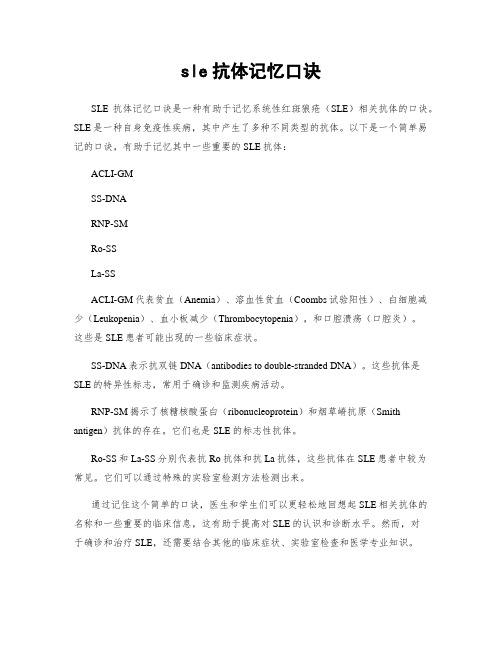
sle抗体记忆口诀
SLE抗体记忆口诀是一种有助于记忆系统性红斑狼疮(SLE)相关抗体的口诀。
SLE是一种自身免疫性疾病,其中产生了多种不同类型的抗体。
以下是一个简单易记的口诀,有助于记忆其中一些重要的SLE抗体:
ACLI-GM
SS-DNA
RNP-SM
Ro-SS
La-SS
ACLI-GM代表贫血(Anemia)、溶血性贫血(Coombs试验阳性)、白细胞减少(Leukopenia)、血小板减少(Thrombocytopenia),和口腔溃疡(口腔炎)。
这些是SLE患者可能出现的一些临床症状。
SS-DNA表示抗双链DNA(antibodies to double-stranded DNA)。
这些抗体是SLE的特异性标志,常用于确诊和监测疾病活动。
RNP-SM揭示了核糖核酸蛋白(ribonucleoprotein)和烟草嵴抗原(Smith antigen)抗体的存在。
它们也是SLE的标志性抗体。
Ro-SS和La-SS分别代表抗Ro抗体和抗La抗体,这些抗体在SLE患者中较为常见。
它们可以通过特殊的实验室检测方法检测出来。
通过记住这个简单的口诀,医生和学生们可以更轻松地回想起SLE相关抗体的名称和一些重要的临床信息,这有助于提高对SLE的认识和诊断水平。
然而,对
于确诊和治疗SLE,还需要结合其他的临床症状、实验室检查和医学专业知识。
系统性红斑狼疮抗体谱
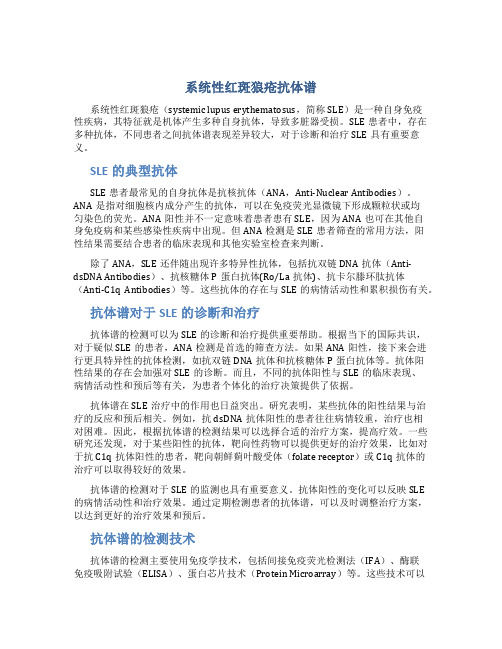
系统性红斑狼疮抗体谱系统性红斑狼疮(systemic lupus erythematosus,简称SLE)是一种自身免疫性疾病,其特征就是机体产生多种自身抗体,导致多脏器受损。
SLE患者中,存在多种抗体,不同患者之间抗体谱表现差异较大,对于诊断和治疗SLE具有重要意义。
SLE的典型抗体SLE患者最常见的自身抗体是抗核抗体(ANA,Anti-Nuclear Antibodies)。
ANA是指对细胞核内成分产生的抗体,可以在免疫荧光显微镜下形成颗粒状或均匀染色的荧光。
ANA阳性并不一定意味着患者患有SLE,因为ANA也可在其他自身免疫病和某些感染性疾病中出现。
但ANA检测是SLE患者筛查的常用方法,阳性结果需要结合患者的临床表现和其他实验室检查来判断。
除了ANA,SLE还伴随出现许多特异性抗体,包括抗双链DNA抗体(Anti-dsDNA Antibodies)、抗核糖体P蛋白抗体(Ro/La抗体)、抗卡尔滕环肽抗体(Anti-C1q Antibodies)等。
这些抗体的存在与SLE的病情活动性和累积损伤有关。
抗体谱对于SLE的诊断和治疗抗体谱的检测可以为SLE的诊断和治疗提供重要帮助。
根据当下的国际共识,对于疑似SLE的患者,ANA检测是首选的筛查方法。
如果ANA阳性,接下来会进行更具特异性的抗体检测,如抗双链DNA抗体和抗核糖体P蛋白抗体等。
抗体阳性结果的存在会加强对SLE的诊断。
而且,不同的抗体阳性与SLE的临床表现、病情活动性和预后等有关,为患者个体化的治疗决策提供了依据。
抗体谱在SLE治疗中的作用也日益突出。
研究表明,某些抗体的阳性结果与治疗的反应和预后相关。
例如,抗dsDNA抗体阳性的患者往往病情较重,治疗也相对困难。
因此,根据抗体谱的检测结果可以选择合适的治疗方案,提高疗效。
一些研究还发现,对于某些阳性的抗体,靶向性药物可以提供更好的治疗效果,比如对于抗C1q抗体阳性的患者,靶向朝鲜蓟叶酸受体(folate receptor)或C1q抗体的治疗可以取得较好的效果。
系统性红斑狼疮_2022年学习资料

©ACR系统性红斑狼疮PPT课件
临床表现->特征性:可急性发-作,也可慢性发作-多为加重与缓解交
◆脏器损害:-皮肤黏膜-80%-关节肌肉-90%-肺胸膜-70%-心血管-胃肠道-50%-肾-神经精神-6 %-血液免疫-其他-合并症与并发症
ACR系统性红斑狼疮PPT课件
©ACR系统性红斑狼疮PPT课件
常见结缔组织病的抗核抗体的阳性率-ANA dsDNA Histone Sm n RNP SSA SSB S L-70]o-1着丝点-核仁-SLE 90-62-50-2540-39-10-ss-15-30-14759-SD-27-12-19-20-PM/DM50-13-RA 23-9有指化-◆ANA≥1:40+,抗ds NA≥30%(或≥1:5)
②ACR系统性红斑狼疮PPT课件
©ACR系统性红斑狼疮PPT课件
ACR系统性红斑狼疮PPT课件
©ACR系统性红斑狼疮PPT课件
OAC系统性红斑狼疮PPT课件
©ACR系统性红斑狼疮PPT课件
实验室检查-般性:-常规检查-靶器官检查-炎性实验-细胞体液免疫功能-◆特殊性:-ANA------dsD A-AHA-mDNA-ENA------sm-SSA/SSB-其他---ACL ANCA
ANA由来-均质体-中性粒细胞-DNPDNA-Histone-LE细胞-抗DNP-补林体-LE细胞:并非S E特有,PM、SD、RA、SS等结缔组织病,药物-过敏,慢活肝等亦可阳性。抗DP取代LE细胞的检则
荧光显微镜下ANA的染色型别-◆均质型:与抗组蛋白和抗DNA有关-◆斑点型:与抗ENA有关-◆周边型:与抗 sDNA有关-◆核仁型:4-6sRNA-◆着丝点型:在SD及CREST中出现
抗组蛋白抗体-免疫印迹法-H1 H2A H2B H2A-H2B H3 H4-系统性红斑狼疮-十十十十十+期服异烟肼-++-类风湿关节炎-SLE以IgG型抗组蛋白抗体为主,而长期服烟肼及-RA病人以IgM型为主
SLE继发APS

24小时尿 1.02g/24h 蛋白
诊疗:
患者给予监测母儿情况,禁饮食、抗感染,抗 凝、激素治疗、补液、保肝、保胃、抑酸等支持治 疗,密切监护病情变化,等待期相关化验回复,目 前考虑系统性红斑狼疮继发抗磷脂综合征,给予增 加激素用量,加用羟氯奎,并请风湿科协助诊疗。
目前诊断:
1、结缔组织病 系统性红斑狼疮? 2、继发性抗磷脂综合征 3、肠系膜血管炎 4、血小板减少 5、急性胃炎 6、肝损害 7、轻度贫血 8、孕24周 G2P0
免疫指标 血型抗体筛查阳 性
超敏 CRP65.1 (mg/l)
抗核抗体 1:320
乳酸脱氢酶 508u/l
抗人球蛋白 试验+
凝血
D-II聚体
30.06
尿常规 尿蛋白2+
肝胆胰脾 无异常 肾彩超
血小板109/L
38 谷草 497(u/l)
问题
1、目前患者考虑诊断是什么? 2、进一步的检查? 3、目前的治疗?
白细胞(109/L) 中性粒细胞 (109/L)
9.63
81.2
血红蛋白 97
生化指标 谷丙 313(u/l)
谷草 63(u/l)
凝血
D-II聚体
21.5
血小板109/L 82
患者于2019-07-17再次出现上腹痛,腹痛呈持续性绞痛,疼痛难忍,伴 恶心呕吐,呕吐物为黄色胃内容物,请消化科会诊,建议行胃镜检查。
产科查体:宫高:28cm,腹围:97cm,未扪及 宫缩,胎心:162次/分
2019-07-13 辅助检查
血常规
白细胞(109/L) 中性粒细胞 (109/L)
血红蛋白
11.35
85.6
101
- 1、下载文档前请自行甄别文档内容的完整性,平台不提供额外的编辑、内容补充、找答案等附加服务。
- 2、"仅部分预览"的文档,不可在线预览部分如存在完整性等问题,可反馈申请退款(可完整预览的文档不适用该条件!)。
- 3、如文档侵犯您的权益,请联系客服反馈,我们会尽快为您处理(人工客服工作时间:9:00-18:30)。
Security & Chip Card ICsSLE 66C322P16-Bit Security Controllerwith Memory Management and Protection Unitin 0.22 µm CMOS Technology136-Kbytes ROM, 4352 bytes RAM, 32-Kbytes EEPROM Short Product Information 08.01SLE 66C322P Short Product Information Ref.: SPI SLE 66C322P 0801.doc This document contains preliminary information on a new product under development. Details are subject to change without notice.Revision History:Current Version 08.01Previous Releases:Page Subjects (changes since last revision)Important:Further information is confidential and on request. Please contact:Infineon Technologies AG in Munich, Germany,Security & Chip Card ICs,Tel +49 - (0)89 234-80000Fax +49 - (0)89 234-81000E-Mail: security.chipcard.ics@Edition 2001Published by Infineon Technologies AG, CC Applications GroupSt.-Martin-Strasse 53, D-81541 München© Infineon Technologies AG 2001All Rights Reserved.Attention please!The information herein is given to describe certain components and shall not be considered as warranted characteristics.Terms of delivery and rights to technical change reserved.We hereby disclaim any and all warranties, including but not limited to warranties of non-infringement, regarding circuits, descriptions and charts stated herein.Infineon Technologies is an approved CECC manufacturer.InformationFor further information on technology, delivery terms and conditions and prices please contact your nearest Infineon Technologies Office in Germany or our Infineon Technologies Representatives world-wide (see address list).WarningsDue to technical requirements components may contain dangerous substances. For information on the types in question please contact your nearest Infineon Technologies Office.Infineon Technologies Components may only be used in life-support devices or systems with the express written approval of Infineon Technologies, if a failure of such components can reasonably be expected to cause the failure of that life-support device or system, or to affect the safety or effectiveness of that device or system. Life support devices or systems are intended to be implanted in the human body, or to support and/or maintain and sustain and/or protect human life. If they fail, it is reasonable to assume that the health of the user or other persons may be endangered.16-Bit Security Controller with MMU in 0.22µm CMOS Technologie 136 Kbytes ROM, 4352 bytes RAM, 32 Kbytes EEPROMFeatures•16-bit microcomputer in 0.22 µm CMOS technology•Instruction set opcode compatible with standard SAB 8051 processor •Enhanced 16-bit arithmetic •Additional powerful instructions optimized for chip card applications •Dedicated, non-standard architecture with execution time 6 times faster (18 times by PLLmax) than standard SAB 8051processor at external same clock •134 Kbyte User ROM for application programs•Additional 2 Kbyte reserved ROM for Resource Management System (RMS+light) with intelligent EEPROM write/erase routines•32 Kbytes Slim-EEPROM• 4 Kbytes XRAM, 256 Bytes IRAM •Memory Management and Protection Unit (MMU)•CRC Module•Interrupt Module•Two 16-bit Autoreload Timer•PLL•Power saving sleep mode •External clock frequency 1 to 7.5 MHz for internal clock ≤ 10 MHz•UART for handling serial interface in accordance with ISO/IEC 7816 part 3supporting transmission protocols T=1 and T=0•I/O routines realized in software executable •Supply voltage range: 2.7 V to 5.5 V •Current consumption< 10mA @ 5.5 V< 6 mA @ 3.3 V•Temperature range: -25 to +85°C •ESD protection larger than 6 kV S lim-EEPROM•Reading, erasing and writing byte by byte •Flexible page mode for 1 to 64 bytes write/erase operation•32 bytes security area (OTP)•Fast personalization mode•Erase + Write time < 4.5 ms •Minimum of 500.000 write/erase cycles at 25°C•Data retention for a minimum of 10 years •EEPROM programming voltage generated on chipM emory Management and Protection Unit •Addressable memory up to 1 Mbyte •Separation OS (system) and application (user)•System routines called by traps•OS can restrict access to peripherals in application mode•Code execution from XRAM possibleS ecurity FeaturesOperation state monitoring mechanism •Low and high voltage sensors •Frequency sensors and filters•Glitch SensorMemory Security•16 bytes security PROM, hardware protected •Unique chip identification number for each chip•MED - memory encryption/decryption device for XRAM, ROM and EEPROM•True Random Number Generator with Firmware test function•Security optimised layout and layoutscramblingTestmode•Irreversible Lock - Out of testmodeAnti Snooping•HW-countermeasures against SPA/DPA-, Timing- and DFA-attacks (differential fault analysis – DFA)•CRC – Module•Non standard dedicated Smart Card CPU – CoreS upport•HW-& SW-Tools (Emulator, ROM Monitor, Card Emulator, Simulator, Softmasking)•Application notesSupported Standards•ISO/IEC 7816•EMV 2000•GSM 11.1x•ETS I TS 102 221Document References•Confidential Data Book SLE 66CxxxP •Qualification report•Chip delivery specification for wafer with chip-layout (die size, orientation,...)•Module specification containing description of package, etc.•Qualification report moduleDevelopment Tools Overview•Short Product Information Software Development Kit SDK CC•Short Product Information Card Emulator CE66P•Short Product Information ROM Monitor RM66P•Short Product Information Emulator ET66P Hitex or ET66P KSC•Short Product Information Smart Mask PackageOrdering InformationType Package1VoltageRange TemperatureRangeFrequency Range(ext. Clockfrequency)SLE 66C322P M5M5SLE 66C322P C die2.7 V - 5.5 V– 25°C to + 70°C 1 MHz – 5 MHzSLE 66C322P-T85 M5M5SLE 66C322P-T85 C die2.7 V - 5.5 V– 25°C to + 85°C 1 MHz – 5 MHzSLE 66C322P-F7 M5M5SLE 66C322P-F7 C Die2.7 V - 5.5 V– 25°C to + 70°C 1 MHz – 7.5 MHzProduction sites:•Dresden SLE66CxxxP•UMC Taiwan SLE66CxxxPU1 available as wire-bonded module (M5) for embedding in plastic cards or as die (C) for customer packagingPin ConfigurationFigure 1: Pin ConfigurationPin Definitions and Functions Symbol FunctionVCC Operating voltage RST Reset inputCLK Processor clock input GND GroundI/O Bi-directional data portGeneral DescriptionSLE 66C322P is another member of Infineon Technologies high-end security controller family in advanced 0.22 µm CMOS technology. The CPU provides the high efficiency of the SAB 8051-instruction set extended by additional powerful instructions together with enhanced performance, memory sizes and security features. The internal clock frequency can be adjusted up to 10 MHz independent of the clock rate of the terminal with the help of the PLL.The controller IC offers 134 Kbytes of User-ROM, 256 bytes internal RAM, 4096 bytes XRAM and 32 Kbytes Slim-EEPROM. The Memory Management and Protection Unit allows a secure separation of the operating system and the applications. Furthermore the MMU makes a secure downloading of applications possible after the personalization of a card. These new features meet the requirements of the next generation of multi application operating systems. For code compatibility to the SLE 66CxxS family, a transparent mode for the MMU is available which allows you to keep the memory mapping of the SLE 66CxxS products.Figure 2: Block Diagram SLE 66C322PThe CRC module allows the easy generation of checksums according to ISO/IEC 3309 (16-Bit-CRC). To minimize the overall power consumption, the chip card controller IC offers a sleep mode. The UART supports the half-duplex transmission protocols T=0 and T=1 according to ISO/IEC 7816-3. All relevant transmission parameters can be adjusted by software, as e.g. the clock division factor, direct/inverse convention and the number of stop bits. Additionally, the I/O port can be driven by communication routines realized in software.The random number generator (RNG) is able to supply the CPU with true random numbers under all conditions.As an important measure, the chip provides a new and enhanced level of on-chip security features.In conclusion, the SLE 66C322P fulfills the requirements of today's chip card applications, as GSM, and offers a powerful platform for future multi application cards. The SLE 66C322P integrates outstanding memory sizes, additional peripherals in combination with enhanced performance and optimized power consumption on a minimized die size. Therefore, the SLE 66C322P offers the basis for a generation of new chip card applications.。
